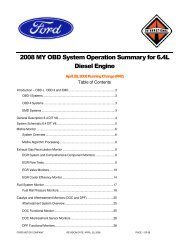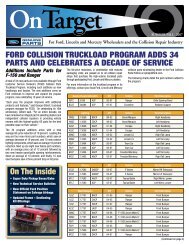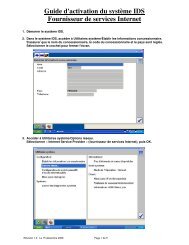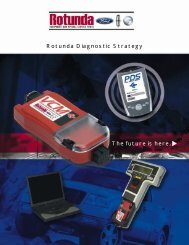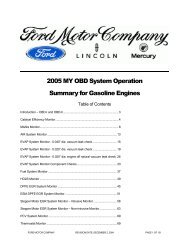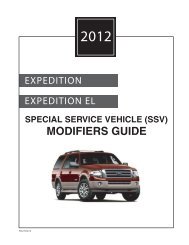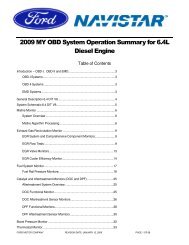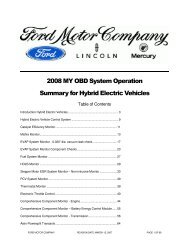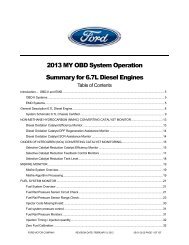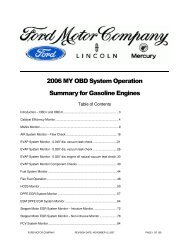OBD Operation Summary for Fiesta - MotorCraftService.com
OBD Operation Summary for Fiesta - MotorCraftService.com
OBD Operation Summary for Fiesta - MotorCraftService.com
- No tags were found...
Create successful ePaper yourself
Turn your PDF publications into a flip-book with our unique Google optimized e-Paper software.
Electronic Throttle ControlThe Electronic Throttle Control (ETC) system uses a strategy that delivers engine or output shaft torque, based ondriver demand, utilizing an electronically controlled throttle body. ETC strategy was developed mainly to improve fueleconomy. This is possible by decoupling throttle angle (produces engine torque) from pedal position (driver demand).This allows the powertrain control strategy to optimize fuel control and transmission shift schedules while delivering therequested engine or wheel torque.ETC System Failure Mode and Effects Management:EffectNo Effect on DrivabilityRPM Guard w/ PedalFollowerRPM Guard w/ DefaultThrottleRPM Guard w/ ForcedHigh IdleShutdownFailure ModeA loss of redundancy or loss of a non-critical input could result in a fault that doesnot affect drivability. The ETC light will turn on, but the throttle control and torquecontrol systems will function normally.In this mode, torque control is disabled due to the loss of a critical sensor or ECMfault. The throttle is controlled in pedal-follower mode as a function of the pedalposition sensor input only. A maximum allowed RPM is determined based on pedalposition (RPM Guard.) If the actual RPM exceeds this limit, spark and fuel are usedto bring the RPM below the limit. The ETC light and the MIL are turned on in thismode and the corresponding trouble code will be stored.In this mode, the throttle plate control is disabled due to the loss of Throttle Position,the Throttle Plate Position Controller, or other major Electronic Throttle Body fault.A default <strong>com</strong>mand is sent to the TPPC, or the H-bridge is disabled. Depending onthe fault detected, the throttle plate is controlled or springs to the default (limphome) position. A maximum allowed RPM is determined based on pedal position(RPM Guard.) If the actual RPM exceeds this limit, spark and fuel are used to bringthe RPM below the limit. The ETC light and the MIL are turned on in this mode andthe corresponding trouble code will be stored.This mode is caused by the loss of 2 or 3 pedal position sensor inputs due tosensor, wiring, or ECM faults. The system is unable to determine driver demand,and the throttle is controlled to a fixed high idle airflow. There is no response to thedriver input. The maximum allowed RPM is a fixed value (RPM Guard.) If the actualRPM exceeds this limit, spark and fuel are used to bring the RPM below the limit.The ETC light and the MIL are turned on in this mode and the correspondingtrouble code will be stored.If a significant processor fault is detected, the monitor will <strong>for</strong>ce vehicle shutdown bydisabling all fuel injectors. The ETC light and the MIL are turned on in this modeand the corresponding trouble code will be stored.Note: Vehicle shutdown does not increase emissions; there<strong>for</strong>e the MIL is notrequired to be illuminated <strong>for</strong> this fault.Note: ETC illuminates or displays a message on the message center immediately,MIL illuminates after 2 driving cyclesCONTINENTAL REVISED: SEPTEMBER 17, 2010 PAGE 77 OF 111



